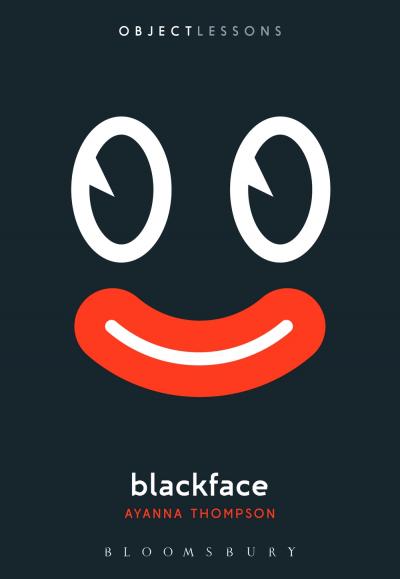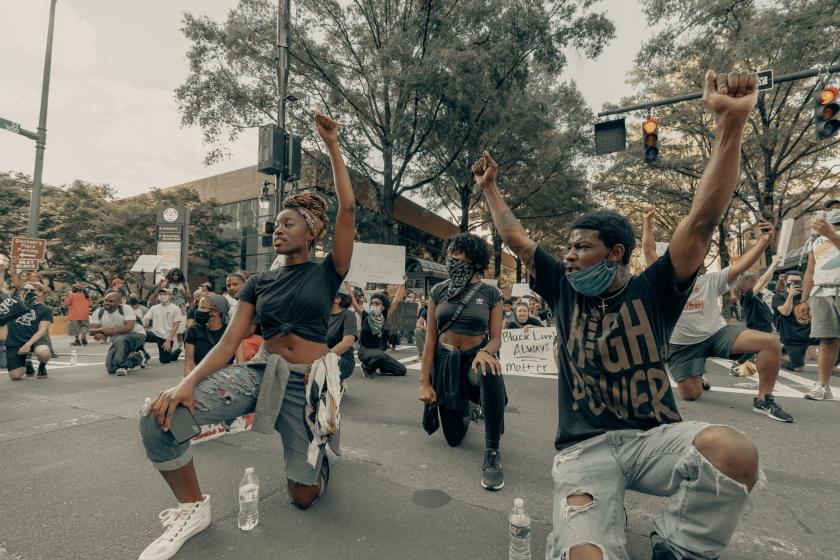Nearly a year has passed since George Floyd was killed by Minneapolis police on 25 May. Nearly 200 have passed since the birth of “blackface minstrelsy” as a performance mode: white actors applying racial prosthetics to perform and make a mockery of black characters. In Blackface, an essential history of this racist performance tradition, which examines its legacy as well as its origins, scholar-activist Ayanna Thompson lays bare the logic that links the two events: “a filthy and vile thread” connecting performances of blackness with anti-black racism. The following is an excerpt from the book’s conclusion.
The brutality and senselessness of George Floyd’s killing has stunned the world, and protests in both large and small cities have sprung up in the United States, United Kingdom, France, Canada, Italy, Iran, and many other countries. There is a renewed interest in the Black Lives Matter movement fuelled by a thirst for change, for systemic change, and for informed dialogues about race, racism, and the specific contours of anti-black racism. Many of the protestors involved are young white people, members of Generation Z.
It is hard to describe the depth of the pain and trauma that Floyd’s killing has inspired in many, including me. Any black scholar who works on racism becomes adept at compartmentalizing their research so as to be able to stay sane, but I could not keep the damage and the suffering in a neat little box in the aftermath of Floyd’s killing. And I could not pretend that there was no relationship between the topic of this book and the way those officers treated George Floyd. There is a filthy and vile thread—sometimes it’s tied into a noose—that connects the first performances of blackness on English stages, the birth of blackface minstrelsy, contemporary performances of blackness, and anti-black racism. Yes, there are important differences between the years 1520, 1820, and 2020, but there are also ties that continue to bind and to make me feel that I can’t breathe.
One of the ties is this sense that performing blackness is still a white property. In the midst of the protests against anti-black racism, several white influencers posted Instagram images of themselves as black—in black makeup—in what they intended to be performances of solidarity. The posts were mainly from Eastern European and Middle Eastern women, and they believed they were expressing support for blacks around the world. One was posted by the Lebanese vocalist Tania Saleh who was “sporting a photoshopped Angela Davis-esque Afro and black skin paint. The photo was captioned ‘wish I was black, today more than ever . . . Sending my love and full support to the people who demand equality and justice for all races anywhere in the world.’” The Algerian artist Souhila Ben Lachhab posted a photo of herself with half her body painted brown. Her post stated: “Just because we’re black on the outside, doesn’t mean we’re black on the inside,” she wrote unironically. “Racist people are the true black heart ones. They are black on the inside, and they know it”2. 1520, 1820, 2020—how much distance is there when these posts are performances of solidarity, support, and a belief that black lives matter?
[…]
Just this week Tina Fey, the creator and executive producer of the sitcom 30 Rock, announced that four episodes of the show that featured blackface are now removed from the platforms that stream the show; 30 Rock ran from 2006 to 2013 and was a satire of a live comedy late-night sketch show, like SNL. In letter to the streaming services, Fey explained, “As we strive to do the work and do better in regard to race in America, we believe that these episodes featuring actors in race-changing makeup are best taken out of circulation . . . I understand now that ‘intent’ is not a free pass for white people to use these images. I apologize for pain they have caused. Going forward, no comedy-loving kid needs to stumble on these tropes and be stung by their ugliness. I thank NBC Universal for honoring this request.” The four episodes that included blackface performances are: season three’s “Believe in the Stars”; season five’s “The Live Show” and “Christmas Attack Zone”; and season six’s “Live from Studio 6H.” To be clear, these episodes were all created, filmed, and aired when Barack Obama was the forty-fourth president of the United States. Nicholas Sammond’s 2015 book, Birth of an Industry, made the connection between Fey’s “edgy” race humor and President Obama’s election painfully clear. Sammond argues, “the wink and nod moment following the election of an African American president . . . somehow generated permission for media producers to more freely express racist stereotypes and sentiments under the dictum that a forthright acknowledgment of racism also provides for its ironic absolution . . .” After the killing of George Floyd, Fey no longer felt the cover of an “ironic absolution” and decided that no one—especially children… should have to stumble innocently on the “fun” of blackface.
 Another sign that white artists are understanding that racialized performances should no longer be their property comes with the announcement that The Simpsons will no longer allow white actors to voice the characters of non-white characters. After thirty-one years on the air (!), the creators have said that “Moving forward, The Simpsons will no longer have white actors voice nonwhite characters.” While Hank Azaria’s voicing of the Indian immigrant, Apu, has garnered a lot of criticism over the years, there are several other characters of colour on The Simpsons who are voiced by white actors, “including Homer Simpson’s workmate, Carl Carlson, (played by Azaria) and the Simpson family physician, Dr. Hibbert (played by Harry Shearer).” Similarly, the hit animated show Family Guy will cease to have a black character voiced by a white actor. As reported in the New York Times, “Mike Henry, a Family Guy voice actor who is white, said in a tweet that he would no longer play the role of Cleveland Brown, a black character who has appeared on that series since its debut in 1999. ‘It’s been an honour to play Cleveland on Family Guy for 20 years,’ Henry wrote in his tweet. ‘I love this character, but persons of colour should play characters of colour. Therefore, I will be stepping down from the role.’” Likewise, Kristen Bell and Jenny Slate, two white actresses who voice bi-racial characters on separate animated shows, have indicated that they intend to stop doing so as well. After the killing of George Floyd, white artists have started to acknowledge that performing blackness should not be a white property, regardless of their intentions—love, satire, or comedy in general.
Another sign that white artists are understanding that racialized performances should no longer be their property comes with the announcement that The Simpsons will no longer allow white actors to voice the characters of non-white characters. After thirty-one years on the air (!), the creators have said that “Moving forward, The Simpsons will no longer have white actors voice nonwhite characters.” While Hank Azaria’s voicing of the Indian immigrant, Apu, has garnered a lot of criticism over the years, there are several other characters of colour on The Simpsons who are voiced by white actors, “including Homer Simpson’s workmate, Carl Carlson, (played by Azaria) and the Simpson family physician, Dr. Hibbert (played by Harry Shearer).” Similarly, the hit animated show Family Guy will cease to have a black character voiced by a white actor. As reported in the New York Times, “Mike Henry, a Family Guy voice actor who is white, said in a tweet that he would no longer play the role of Cleveland Brown, a black character who has appeared on that series since its debut in 1999. ‘It’s been an honour to play Cleveland on Family Guy for 20 years,’ Henry wrote in his tweet. ‘I love this character, but persons of colour should play characters of colour. Therefore, I will be stepping down from the role.’” Likewise, Kristen Bell and Jenny Slate, two white actresses who voice bi-racial characters on separate animated shows, have indicated that they intend to stop doing so as well. After the killing of George Floyd, white artists have started to acknowledge that performing blackness should not be a white property, regardless of their intentions—love, satire, or comedy in general.
- Excerpted from Blackface by Ayanna Thompson (Bloomsbury's Object Lessons Series, £9.99)
- Read more book reviews and features on theartsdesk















Add comment